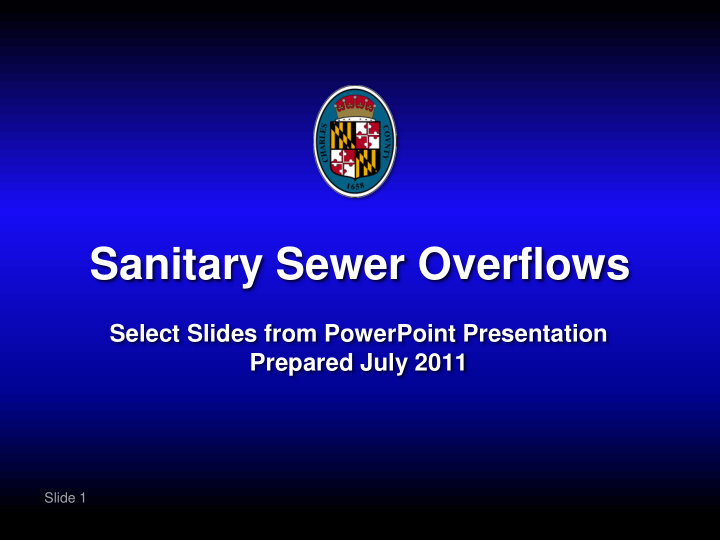



Sanitary Sewer Overflows Select Slides from PowerPoint Presentation Prepared July 2011 Slide 1
Sanitary Sewer Overflow • “Sanitary Sewer Overflow (SSO)” means a discharge of untreated or partially treated sewage from a separate sewer system before the sanitary wastewater reaches the headworks of a wastewater treatment facility, pursuant to COMAR 26.08.10.01. Slide 2 Sanitary Sewer Overflows
Unauthorized Discharge • An “Unauthorized Discharge” is the release of fully treated and disinfected wastewater at a location other than the discharge point, or outfall, listed in the plant’s NPDES permit. Slide 3 Sanitary Sewer Overflows
Sanitary Sewer Overflows • EPA estimates that nationally there are at least 23,000 to 75,000 SSOs per year (not including sewage backups into buildings). * • Even though systems are intended to collect and contain all the sewage that flows into them, SSOs occasionally occur in almost every sewer system. * http://cfpub.epa.gov/npdes/home.cfm?program_id=4 Slide 4 Sanitary Sewer Overflows
MDE Zero Tolerance • MDE adopted a Zero Tolerance policy in March, 2005 (effective January 1, 2009) for SSO events • Many Maryland wastewater agencies feel that the policy is unrealistic. SSO’s, while not desirable, do happen • MDE has developed a sliding scale of fines and penalties for SSO events • Charles County actually has a good record for SSO’s Slide 5 Sanitary Sewer Overflows
Charles County DPW - Utilities SSO Events 2004 - 2010 28 24 Number of SSO Events 22 20 20 18 16 15 Rain SSO's 15 R² = 0.8123 12 # of SSO's 10 SSO Trendline 10 8 9 5 5 4 3 4 1 0 0 2004 2005 2006 2007 2008 2009 2010 Year Charles County Sanitary Sewer Overflows and Rain-Caused Overflows Slide 6 Sanitary Sewer Overflows
Charles County Sewer History • The County’s earliest collection system lines date from 1950’s and 1960’s and are still in use • The collection system as we know it today is made up of formerly independent sewer districts • Construction and Inspection services were not consistent among the districts Slide 7 Sanitary Sewer Overflows
Causes of SSO Events • Infiltration and Inflow (I&I) (heavy rains, roof leaders connected to sewer, cracked and broken pipes) • Equipment Failure (pipes, pumps, sensors) • Grease, rags (difficult to control residential discharges) • Power Failures (brown outs, black outs and storm-caused power failures) • Vandalism (sticks, trash, other debris deliberately dumped in manholes) Slide 8 Sanitary Sewer Overflows
Causes of SSO Events (Cont’d) • Infrastructure Deterioration (age, cracks, breaks, pipe / manhole failure due to corrosion) • Design and Construction Issues (improper materials, undersized pipes, improper grade, “bellies” or humps in pipes) • Contractor negligence (pipe plugs and construction debris lost in system) • 3 rd Party Damage (directional drilling through pipe) Slide 9 Sanitary Sewer Overflows
Corrective Actions • DPW has an on-going I&I capital project developing and implementing an action plan • Utilities has an in-house I&I team and a sewer cleaning crew to help monitor SSO “hot spots” • Westin Project – SCADA for notification of problems – INFOR automatically generates cleaning schedules Slide 10 Sanitary Sewer Overflows
Corrective Actions (continued) • Install redundant alarm sensors – e.g., a float level sensor to back up a bubbler system • Upgrades to the Mattawoman influent / effluent pump station – Interim plan replaced bar screen and grit removal units – Refurbished an existing pump and will install a new pump Slide 11 Sanitary Sewer Overflows
Utilities takes SSO’s VERY seriously • Staff are trained to deal with SSO’s, including: – Full investigation of the cause of any SSO – MDE and CCHD reporting requirements – Debriefing following an SSO event – Initiation of follow-up actions, as appropriate, to prevent SSO re-occurrence – Clear SSO Standard Operating Guidelines, first distributed in 2004 and regularly reviewed and updated Slide 12 Sanitary Sewer Overflows
However… • SSO’s cannot be completely eliminated: – We simply cannot foresee the unforeseeable – We cannot stop natural events such as torrential rains – We cannot always tell exactly what is happening underground – Man made materials and construction techniques have finite life spans Slide 13 Sanitary Sewer Overflows
Mattawoman Creek Flooding Due to Torrential Rains, May 12, 2008 Note orange manhole location stake in photo on left. The manhole is completely under water. The creek is normally only a few feet wide. Slide 14 Sanitary Sewer Overflows
Broken Sewer Pipe Utilities crew is about to install a stainless steel sleeve to repair the break. This particular pipe is among the oldest in the Waldorf collection system. Slide 15 Sanitary Sewer Overflows
Panda Line Pipe Failure During construction, the protective lining of the pipe was damaged. The damage occurred 11 years prior to the pipe failure and resulted in an Unauthorized Discharge. Slide 16 Sanitary Sewer Overflows
Recommend
More recommend